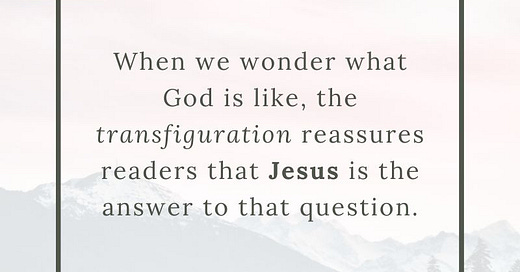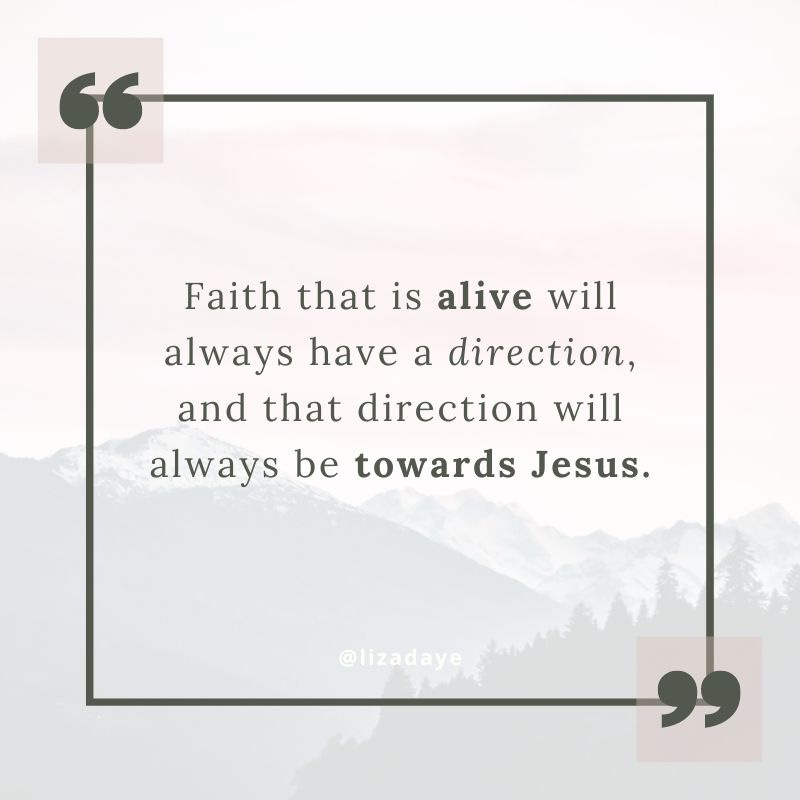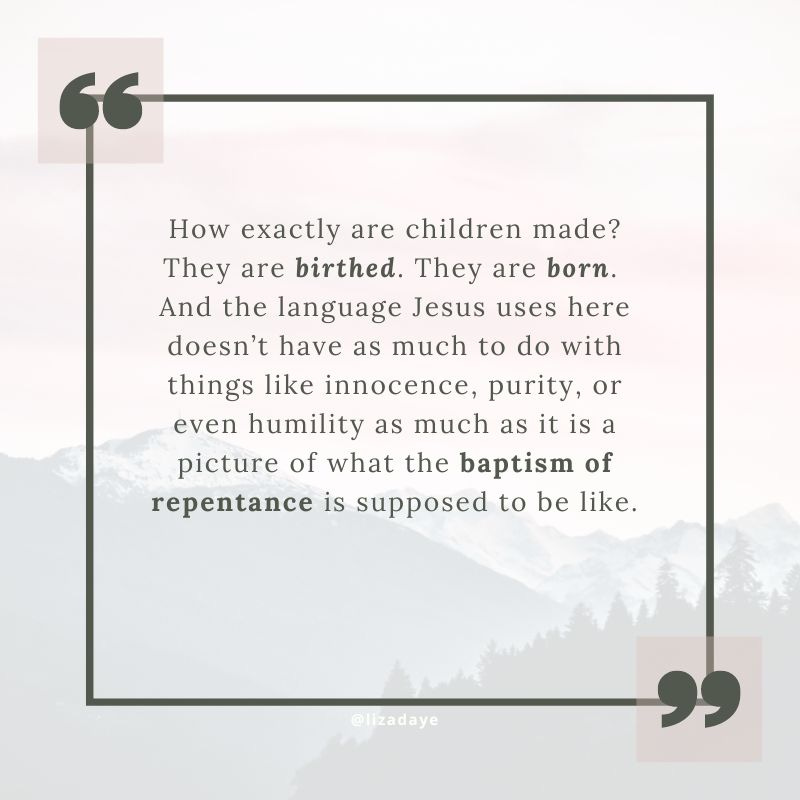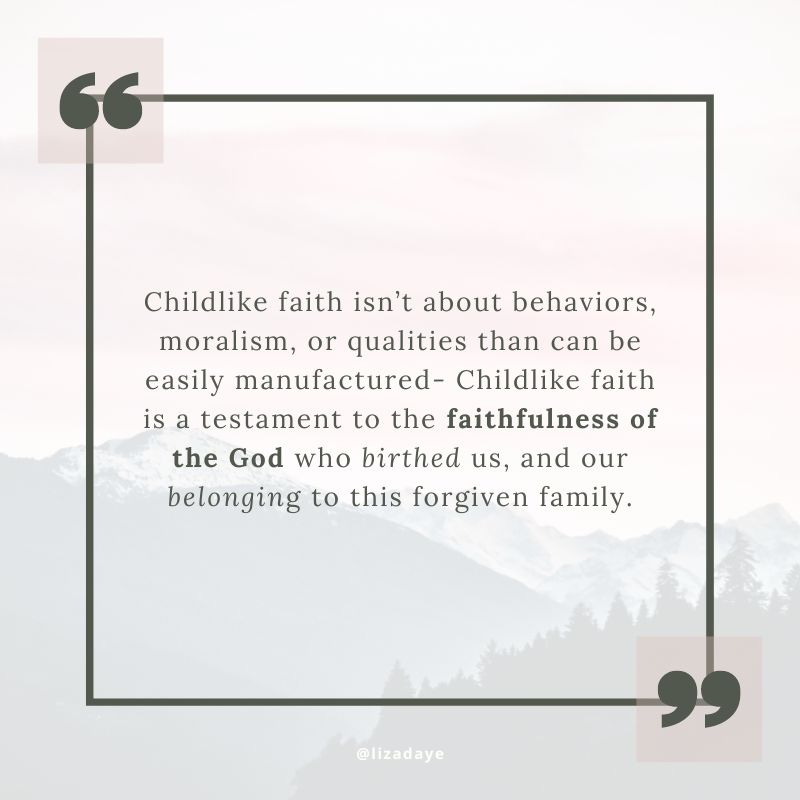I have a confession. Lately my faith has felt a bit fragile. With so much going on in the world and in our family, faith feels like a strange afterthought at times. It’s almost as if I forget how to treat it or how to use it. And if we’re honest this happens to many of us. Mid trauma we have to remember how to practice our faith muscles, but sometimes we fail to recall what they’re even there for. So, we default. We treat faith like a formula- a quid pro quo. A bargaining chip to get what we want out of the situation. And while I can typically attempt to justify my own motives here and swear up and down that they aren’t so insidious or even sloppy, the truth is that often in evangelicalism we muddy the conceptualization of what our faith is supposed to be, with God’s own faithfulness. So, let’s talk about it a little bit. Let’s talk about childlike faith from the book of Matthew.
a quick hermeneutical note
One reason that I prefer referencing pericopes over prooftexts is that I believe our God is one of contextualization. God chose to become incarnate in a particular time and place and body so as to remind us that everything in scripture isn’t for everyone all the time. The bible isn’t a collection of pick & choose proverbs. The incarnation in particular reminds us that the library of scripture is God’s story about who God is and what God is like, and like our beloved RHE used to say, “His children’s fingerprints are all over the pages.” So, when we’re exploring scripture and wondering about the character of God, rather than hovering our curser over the English word for “faithful” and sifting through the single verse response until we choose the one that applies to our situation on our own terms, let’s consider whole, messy, complicated stories. Today we’re going to explore this idea of childlike faith in scripture. And since the child-like faith that Jesus teaches about is revealed in Matthew 18, lets actually begin in chapter 17. Why? Because knowing the general vibe and structure of what’s going on in some of these books helps us to read them in context.
Chapter 17 is the second time that the Father announces Jesus’ sonship, the first time occurring at his baptism. But the Father goes a step further and the transfiguration serves as one of the ultimate revelations in all of scripture. Bedazzled Jesus is one of my all-time favorite moments, because here, The Father reveals Jesus as the fulfillment of the law and prophets to his friends. When we wonder what God is like, the transfiguration reassures readers that Jesus is the answer to that question. When Peter opens his stupid trap and attempts to equate Jesus with Elijah and Moses through a suggestion to build them each a tent, The Father speaks saying “This is my Son, with whom I am well-pleased and delighted! Listen to him.” (17:5)
Jesus’ besties were terrified into a literal stupor, but Jesus doesn’t respond by gaslighting them or minimizing the enormity of what is happening. He reminds them of their shared humanity. Jesus, before saying a word, reaches out to his friends with a reassuring touch of flesh and skin.
This is important foundationally because the subsequent pericopes deal with faith directly. Upon journeying down the mountain, the disciples attempt to exorcise a demon from a sufferer and are unable to. And we often miss something really important here. Jesus wasn’t frustrated because his disciples didn’t have enough faith to heal the man, but he was frustrated because they didn’t come straight to Jesus. Contrast this situation with the hemorrhaging woman, for example. She was desperate to touch Jesus’ robe. Her belief was in Jesus. Noone else.
Later, when the disciples asked Jesus why they couldn’t remove the demon- and Jesus’ responds with “because of your small faith.” Jesus goes on to say if they have faith that is full of life even if it is small, nothing will be impossible. Who is the way, the truth, and the life? Jesus himself. Faith that is alive will always have a direction, and that direction will always be towards Jesus. Jesus’ direction will always be to show up for humankind with his hands and feet.
So, in all of this strange back and forth about faith and demons, Jesus changes the subject, and he prophesies about the resurrection. But in verse 23 they were visibly grieved and distressed because they didn’t have the imagination for resurrection yet. Their faith wasn’t yet alive with the life of Christ.
By the time the disciples arrive in Capernaum in verse 24, Jesus and his friends have a very grown up very serious conversation about paying taxes (according to exodus 30:13) But Jesus does a couple really interesting things that not only reveal his priorities, but also his utter unseriousness.
Jesus and Peter begin talking about who is supposed to pay a particular tax that is reserved for foreigners. Jesus has a choice whether to align himself as a citizen or a stranger, and he chose solidarity with the foreigners. Then what happened? An unbothered Jesus tells his buddies to go fishing so as to precure the sheckle to pay the tax. Not sell the fish- but there would be a floppy wet fish swimming around with a coin in its mouth.
The lengths that Jesus goes to align himself with outsiders when he doesn’t have to, and the mockery he makes of the ways in which humans draw distinctions between us versus them is audacious in the best way. The disciples probably weren’t giggling, but I’d bet that sheckle that Jesus was.
Keeping all this background in mind, (the revelation of Jesus as what God is like, Jesus’ longing for followers with vibrant lively faith, and the practical joke he played on his friends), we come to our passage referencing childlikeness in faith.
In chapter 18 Jesus’ buddies have been bickering about who amongst them is the greatest, as men do. But Jesus responds by calling a child over to his lap as he begins to teach to the mixed crowd of adults and children, encouraging them all to repent from their obsessions with greatness and stature, and become like the children in their midst. How exactly are children made? They are birthed. They are born. And the language Jesus uses here doesn’t have as much to do with things like innocence and purity and even humility as it is a picture of what the baptism of repentance is supposed to be like.
When we believe, we are filled with the holy spirit, the life of God within us, and we are birthed by God into newness of life with God and God’s family. If we continue layering this birthing metaphor on top of the text, we can imagine that this idea of “receiving and welcoming” as spiritual midwifery. As God births each of us into newness of life through the sharing of the spiritual death, burial, and resurrection of Jesus, the family of God are to become welcomers to future newcomers to the family of God.
So, what then is childlike faith? Id argue that childlike faith involves allowing ourselves to be reborn by the power of the Spirit. And as we grow up in the family filled with everlasting life, people of faith serve as siblings first, nurses, doctors, midwives second. We’re a whole care team, a whole support system. We champion rebirth because we were once reborn. We champion resurrection because we were as good as dead when we were obsessed with money and status and implementing harmful hierarchies that inhibit the ways in which we belong to one another. But now, we’re alive with God, together, filled with faith for one another.
Childlike faith isn’t about behaviors, moralism, or qualities than can be easily manufactured- Childlike faith is a testament to the faithful God who birthed us, and our belonging to this family.
So, when my faith feels small, and like the disciples who were unable to drive out those pesky demons and I feel frustrated about the limits of faith, I take comfort in the flickering fire of life, because I know it rests somewhere deep inside my mustard-seed-sized kernel. It’s okay if my faith is small because my God is faithful. It’s okay if I can’t wield it like a magical spell because I’m not supposed to.
My faith is inseparably linked to my birth, my belonging to God’s family, and my willingness to welcome well. My faith is a result of God birthing me, and the midwives who received me and pointed me towards Jesus over and over. And my faith is the result of a smiling Jesus, arms wide, inviting me to rest in his love. Maybe just maybe my faith isn’t supposed to be a power wielding signet. Maybe it’s the reminder of the link between me and maker, the umbilical cord between my rebirthed spirit and the God who birthed me into new life. Maybe faith is breastmilk. And the bond of begotteness. And maybe mature faith looks like triage, obstetrics, and pediatric care, joining with the birthing Spirit like Paul suggested in Galatians. Maybe mature faith looks like participation and partnering with the divine for the flourishing of the family of God.
This imagery of an interconnected faith comforts me and grounds me. It doesn’t provide empty answers or a formula. It isn’t a performance. It’s the ever-present reminder that to believe is to belong and that belonging enlivens the entirety of our being in Christ.
Friends, I know the world is a mess right now. There’s no shortage of heaviness- brokenness. Spiritual stillbirth and infant mortality.
But faith keeps us connected. Faith holds us by no power of our own. Our Faithful Father whispers lullabies deep within our souls and reminds us that we are His cherished children.
As always, thank you for reading my work and supporting my writing. One of the best ways to do that right now is to subscribe here, so that when this book that I’m working on makes its way into the world, the words I’m sharing can find the right readers. I have a goal in mind that I’d love to meet by summer, and it would bless me beyond measure if you’d consider supporting my journey in this way. This platform is always free, and I try to limit emails to twice a month.
Sending all the love in the world to you and yours.
Liz









